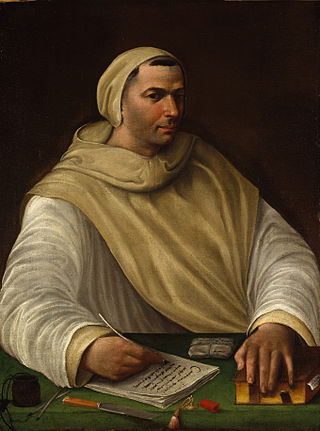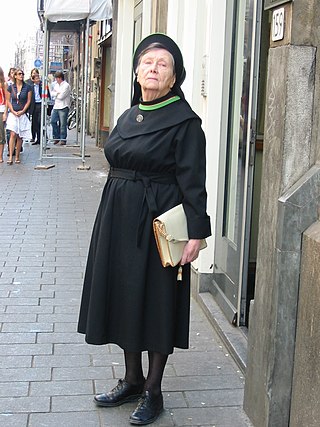Related Research Articles
The Benedictines, officially the Order of Saint Benedict, are a mainly contemplative monastic religious order of the Catholic Church for men and for women who follow the Rule of Saint Benedict. The male religious are also sometimes called the Black Monks, in reference to the colour of their religious habits, in contrast to other Benedictine orders such as the Olivetans, who wear white. They were founded in 529 by Benedict of Nursia, a 6th-century Italian monk who laid the foundations of Benedictine monasticism through the formulation of his Rule. Benedict's sister, Scholastica, possibly his twin, also became a religious from an early age, but chose to live as a hermit. They retained a close relationship until her death.

The Order of the Brothers of the Blessed Virgin Mary of Mount Carmel, known as the Carmelites or sometimes by synecdoche known simply as Carmel, is a mendicant order in the Roman Catholic Church for both men and women. Historical records about its origin remain uncertain; it was probably founded in the 12th century on Mount Carmel.

A nun is a woman who vows to dedicate her life to religious service and contemplation, typically living under vows of poverty, chastity, and obedience in the enclosure of a monastery or convent. The term is often used interchangeably with religious sisters who do take simple vows but live an active vocation of prayer and charitable work.

The Royal Abbey of Our Lady of Fontevraud or Fontevrault was a monastery in the village of Fontevraud-l'Abbaye, near Chinon, in the former French Duchy of Anjou. It was founded in 1101 by the itinerant preacher Robert of Arbrissel. The foundation flourished and became the centre of a new monastic Order, the Order of Fontevraud. This order was composed of double monasteries, in which the community consisted of both men and women — in separate quarters of the abbey — all of whom were subject to the authority of the Abbess of Fontevraud. The Abbey of Fontevraud itself consisted of four separate communities, all managed by the same abbess.

The Trappists, officially known as the Order of Cistercians of the Strict Observance and originally named the Order of Reformed Cistercians of Our Lady of La Trappe, are a Catholic religious order of cloistered monastics that branched off from the Cistercians. They follow the Rule of Saint Benedict and have communities of both monks and nuns that are known as Trappists and Trappistines, respectively. They are named after La Trappe Abbey, the monastery from which the movement and religious order originated. The movement first began with the reforms that Abbot Armand Jean le Bouthillier de Rancé introduced in 1664, later leading to the creation of Trappist congregations, and eventually the formal constitution as a separate religious order in 1892.

Filles du Calvaire is a station on Line 8 of the Paris Métro, at the limit between the 3rd and 11th arrondissements.

François Leclerc du Tremblay, also known as Père Joseph, was a French Capuchin friar, confidant and agent of Cardinal Richelieu. He was the original éminence grise—the French term for a powerful advisor or decision-maker who operates secretly or unofficially.

The Olivetans, formally known as the Order of Our Lady of Mount Olivet, are a monastic order. They were founded in 1313 and recognised in 1344. They use the Rule of Saint Benedict and are a member of the Benedictine Confederation, where they are also known as the Olivetan Congregation, but are distinguished from the Benedictines in their white habit and centralized organisation. They use the post-nominals 'OSB Oliv'.

The English Benedictine Congregation (EBC) is a congregation of autonomous Roman Catholic monastic communities of Benedictine monks and nuns. It is technically the oldest of the nineteen congregations affiliated to the Benedictine Confederation.

The Vallombrosians are a monastic religious order in the Catholic Church. They are named after the location of their motherhouse founded in Vallombrosa, situated 30 km from Florence on the northwest slope of Monte Secchieta in the Pratomagno chain. They use the postnominal abbreviation OSBVall to distinguish themselves from other Benedictines, who generally use the abbreviation OSB.

The Diocese of Orléans is a Latin Church diocese of the Catholic Church in France. The diocese currently corresponds to the Départment of Loiret. The current bishop is Jacques André Blaquart, who was appointed in 2010.

Augustinian nuns are the most ancient and continuous segment of the Roman Catholic Augustinian religious order under the canons of contemporary historical method. The Augustinian nuns, named after Saint Augustine of Hippo, are several Roman Catholic enclosed monastic communities of women living according to a guide to religious life known as the Rule of St. Augustine. Prominent Augustinian nuns include Italian mystic St. Clare of Montefalco and St. Rita of Cascia.

Prosper Louis Pascal Guéranger was a French priest and Benedictine monk, who served for nearly 40 years as the abbot of the monastery of Solesmes. Through the new Abbey of Solesmes, he became the founder of the French Benedictine Congregation, which re-established Benedictine monastic life in France after it had been wiped out by the French Revolution. Guéranger was the author of The Liturgical Year, a popular commentary which covers every day of the Catholic Church's liturgical cycles in 15 volumes. He was well regarded by Pope Pius IX, and was a proponent of the dogmas of the Immaculate Conception and of papal infallibility.
The Congregation of Our Lady of Sion is composed of two religious congregations in the Roman Catholic Church founded in Paris, France. One is composed of priests and religious brothers, founded in 1852, and the other is composed of religious sisters, founded in 1843, both by Marie-Théodore Ratisbonne, along with his brother Marie-Alphonse Ratisbonne, "to witness in the Church and in the world that God continues to be faithful in his love for the Jewish people and to hasten the fulfillment of the promises concerning the Jews and the Gentiles"..

Cistercian nuns are female members of the Cistercian Order, a religious order belonging to the Roman Catholic branch of the Catholic Church.

The Feuillants were a Catholic congregation originating in the 1570s as a reform group within the Cistercians in its namesake Les Feuillants Abbey in France, which declared itself an independent order.
Grovebury Priory, also known as La Grave or Grava was a priory in Leighton Buzzard, Bedfordshire, England. It was established in 1164 and disestablished in 1414.

The Convent of Our Lady of Calvary, also named Convent of the Filles du Calvaire, is a former Roman Catholic convent in Paris, France.

Catherine Gascoigne was the English abbess of Cambrai from 1624 to 1673.

Antoinette d'Orléans-Longueville was a French noble lady, of Capetian ancestry, member of the house of Orléans-Longueville. She was Lady of Château-Gontier and, through her marriage, became the Marquise of Belle-Île. Widowed as a young woman, the wealthy lady became a nun and eventually founded the Benedictine order of Notre-Dame of Calvary in Paris.
References
- Attribution
![]() This article incorporates text from a publication now in the public domain : Herbermann, Charles, ed. (1913). "Congregation of Our Lady of Calvary". Catholic Encyclopedia . New York: Robert Appleton Company. The entry cites:
This article incorporates text from a publication now in the public domain : Herbermann, Charles, ed. (1913). "Congregation of Our Lady of Calvary". Catholic Encyclopedia . New York: Robert Appleton Company. The entry cites:
- Max Heimbucher , Die Orden und Congregationen der katholischen Kirche (Paderborn, 1907)
- Braunmüller in Kirchenlexikon II, 358;
- Hélyot, Dict. des Ordres Religieux (Paris, 1860);
- François-Xavier de Feller, Biographie universelle (Besançon, 1848), VI;
- Constitutions des Bénédictines de la congrégation du Calvaire (Paris, 1635)